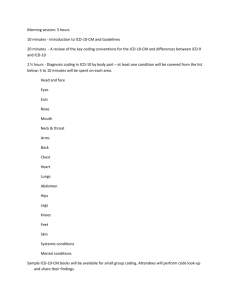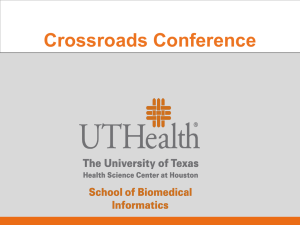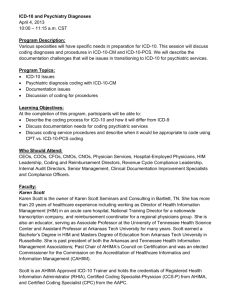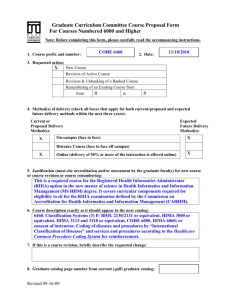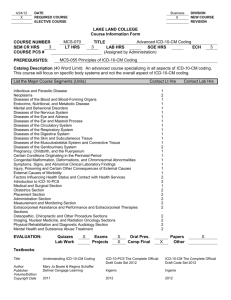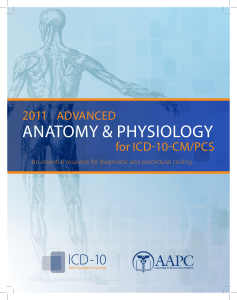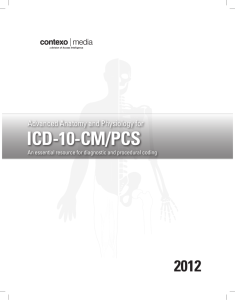ICD-10-PCS
advertisement
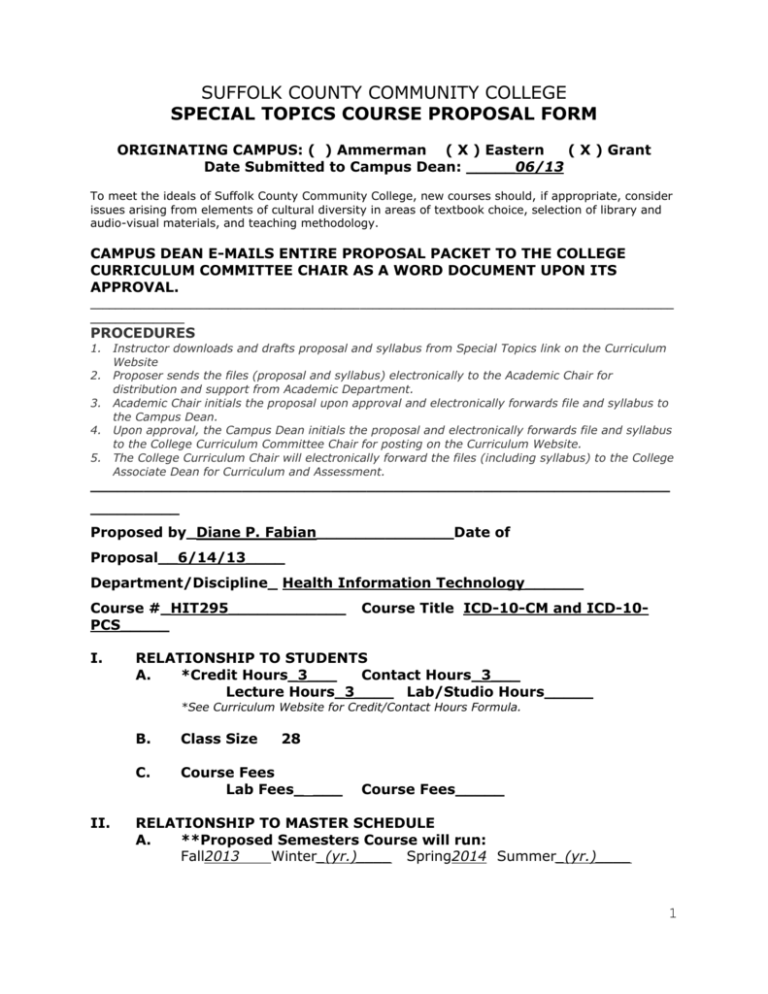
SUFFOLK COUNTY COMMUNITY COLLEGE SPECIAL TOPICS COURSE PROPOSAL FORM ORIGINATING CAMPUS: ( ) Ammerman ( X ) Eastern ( X ) Grant Date Submitted to Campus Dean: _____06/13 To meet the ideals of Suffolk County Community College, new courses should, if appropriate, consider issues arising from elements of cultural diversity in areas of textbook choice, selection of library and audio-visual materials, and teaching methodology. CAMPUS DEAN E-MAILS ENTIRE PROPOSAL PACKET TO THE COLLEGE CURRICULUM COMMITTEE CHAIR AS A WORD DOCUMENT UPON ITS APPROVAL. _____________________________________________________________________________________________ _______________ PROCEDURES 1. Instructor downloads and drafts proposal and syllabus from Special Topics link on the Curriculum Website 2. Proposer sends the files (proposal and syllabus) electronically to the Academic Chair for distribution and support from Academic Department. 3. Academic Chair initials the proposal upon approval and electronically forwards file and syllabus to the Campus Dean. 4. Upon approval, the Campus Dean initials the proposal and electronically forwards file and syllabus to the College Curriculum Committee Chair for posting on the Curriculum Website. 5. The College Curriculum Chair will electronically forward the files (including syllabus) to the College Associate Dean for Curriculum and Assessment. _________________________________________________________________ __________ Proposed by_Diane P. Fabian______________Date of Proposal__6/14/13____ Department/Discipline_ Health Information Technology______ Course #_HIT295____________ PCS_____ I. Course Title ICD-10-CM and ICD-10- RELATIONSHIP TO STUDENTS A. *Credit Hours_3___ Contact Hours_3___ Lecture Hours_3____ Lab/Studio Hours_____ *See Curriculum Website for Credit/Contact Hours Formula. II. B. Class Size 28 C. Course Fees Lab Fees_ ___ Course Fees_____ RELATIONSHIP TO MASTER SCHEDULE A. **Proposed Semesters Course will run: Fall2013 Winter_(yr.)____ Spring2014 Summer_(yr.)____ 1 B. **Projected Termination Date FallFall 2014 Winter_(yr.)____ Summer_(yr.)____ Spring_(yr.)____ **Special Topics courses may run for only two semesters. Upon the completion of the second semester, the course must be withdrawn from the schedule unless it has been re-approved as a Special Topics course or approved as a permanent course. Under no circumstances may a Special Topics course run for more than four semesters. III. Rationale for Course: This course is being offered to meet the needs of the health care community. On October 1, 2014 the coding system will convert to the next version, that is, ICD-10-CM and ICD-10-PCS. This will affect anyone who is involved in health care reimbursement, hospitals, doctor’s offices and insurance companies. Please see the email requests. This course content will be added to the HIT235 in the Fall semester through a curriculum change. IV. Description of Course: This course will introduce ICD-10-CM and ICD-10-PCS ONLY. Students will code using medical records and practice exercises. (3 hrs. lecture.) V. Approvals Department Approval__Diane P. Fabian Date_6/14/13_______ Academic Chair Campus Dean Approval_Evon Walters Date___6/20/13__________ Campus Dean 2 SPECIAL TOPICS • COURSE SYLLABUS PLEASE SEE ATTACHED COURSE SYLLABUS I. Course Number and Title: II. Description of Course: III. Course Objectives: (What should students learn as a result of taking this course and how will they demonstrate that learning?) Upon completion of this course students will: IV. Required Texts and Materials: (List textbooks, newspapers, journals, Internet resources, CD-ROMS, Videos, other teaching materials to be used in the course.) V. Assessment of Student Learning: (Describe assessment measures, i.e., instruments that measure the attainment of course objectives.) VI. Weekly Outline of Topics and Assignments: 3 SUFFOLK COUNTY COMMUNITY COLLEGE WESTERN CAMPUS COURSE SYLLABUS COURSE TITLE: ICD-10-CM and ICD-10-PCS CATALOG NO: HIT 295 CREDIT HOURS: 3 hours INSTRUCTOR: SEMESTER: Phone: Email: COURSE DESCRIPTION: This course will introduce ICD-10-CM and ICD-10-PCS ONLY. Students will code using medical records and practice exercises. (3 hrs. lecture.) STUDENT LEARNING OUTCOMES: Upon completion of the course the student will be able to: 1. Define, identify and list all coding conventions, principal diagnoses, comorbid conditions, principal procedure, and secondary procedures documented in the medical record. 2. Explain the importance of the ICD-10-CM and ICD PCS coding and its application to the Hospital Reimbursement System. 3. Analyze the medical record and properly sequence the ICD-10-CM code. 4. Demonstrate the ability to read a medical record and determine the appropriate ICD-10-CM code. 5. Define the various classification systems including ICD-10-CM 6. Distinguish the differences between a medical vocabulary (SNOMED) and a classification system. INSTRUCTIONAL/TEACHING METHODS: Lecture Homework Assignments Medical Records AHA Coding Clinics EVALUATION: Students require a minimum of "C" to progress in the program. Homework (Coding review) 30% Midterm (Coding problems) Take Home 35% Final (Multiple choice/coding problems) 35% 4 HIT235 ATTENDANCE POLICY: Students are expected to attend all classes. The College defines excessive absence or lateness as more than one week of class meetings during the semester. Excessive absence or lateness may lead to failure or removal from the class roster. TEXT: 2012 ICD-10-CM Channel Publishing and ICD-10-PCS Channel Publishing Basic ICD-10-CM and ICD-10-PCS Coding 2013 by Schraffenberger, AHIMA 2013 ICD-10-CM and ICD-10-PCS 2013 Coding Handbook with Answers by Nellie Leon-Chisen, AHA 2013. DOMAINS, SUBDOMAINS, TASKS: I.A.5. Verify timeliness, completeness, accuracy, and appropriateness of data and data sources for patient care, management, billing reports, registries and/or databases. I.C.1. Use and maintain electronic applications and work processes to support clinical classification and coding. I.C.2. Apply diagnosis/procedure codes using ICD10CM and ICD10PCS. I.C.4. Ensure accuracy of diagnostic/procedural groupings such as DRG, APC and so on. I.C.5. Adhere to current regulations and established guidelines in code assignment. I.C.6. Validate coding accuracy using clinical information found in the health record. I.C.7. Use and maintain applications and processes to support other clinical classification and nomenclature systems (ex. ICD-10-CM, SNOMED, etc.). I.C.8. Resolve discrepancies between coded data and supporting documentation. I.D.1. Apply policies and procedures for the use of clinical data required in reimbursement and prospective payment systems (PPS) in healthcare delivery. 5 CODING AND CLASSIFICATION SYSTEMS HIT 235 GENERAL OUTLINE OBJECTIVE #1: Define, identify and list all coding conventions, principal diagnoses, comorbid conditions, principal procedure, and secondary procedures documented in the medical record. The student will be able to identify the coding conventions, define principal and secondary diagnoses and procedures, and explain the importance of coding in the health care setting. History of Coding ICD-10-CM and ICD-10-PCS Purposes of Coding Importance of Coding to Clinicians ICD-10-CM Text Format ICD-10-CM Conventions Federal Government and Healthcare Uniform Hospital Discharge Data Set (UHDDS) Coding with ICD10CM and ICD10PCS OBJECTIVE #2: Explain the importance of the ICD-10-CM coding and its application to the Hospital Reimbursement System. The student will be able to describe the relationship between coding, reimbursement and the Third Party Payers. Importance of Coding to DRG Reimbursement (DRG) Prospective Payment System (PPS) DRG's and Case Mix Classification Peer Review Organizations (PRO) Corporate Compliance Computerized Grouper AHA Coding Clinics (authoritative source) OBJECTIVE #3: Analyze the medical record and properly sequence the ICD-10-CM code. Using copies of the medical record, the student will review the medical record and select appropriate diagnoses and procedures. Selection of the Principal Diagnosis Selection of all Secondary Diagnoses Procedural Coding Diagnoses Sequencing 6 HIT235 7 Special Topics Course Proposal Form OBJECTIVE #4: Demonstrate the ability to read a medical record and determine the appropriate ICD10-CM code. The student will read copies of medical records and case studies and determine the appropriate codes. Signs, Symptoms and Ill-defined Conditions Infections and Parasitic Diseases Endocrine, Nutritional, and Metabolic Diseases and Immune Disorders Mental Disorders Diseases of Blood and Blood Forming Organs Diseases of Nervous System and Sensory Organs Diseases of Respiratory System Digestive System Diseases of Genitourinary System Diseases of Skin and Subcutaneous Tissue Diseases of Musculoskeletal and Connective tissue Complications of Pregnancy, Childbirth and the Puerperium Abortion Congenital Anomalies Perinatal Conditions Diseases of the Circulatory System Neoplasms Injuries, Burns and Poisonings OBJECTIVE #5: Define the various classification systems including ICD-10-CM. The student will read copies of medical records and case studies and determine the appropriate codes. ICD-10-CM Text Format ICD-10-CM Conventions ICD-10-PCS Extension Codes OBJECTIVE #6 Distinguish the differences between a medical vocabulary (SNOMED) and a classification system. The student will be able to distinguish between a nomenclature and classification system. Nomenclature History SNOMED Classification History Systems for Various Healthcare Settings SUFFOLK COUNTY COMMUNITY COLLEGE ALL FORMS MUST BE SUBMITTED ELECTRONICALLY 9/2006 Special Topics Course Proposal Form HIT 295 WEEKLY OUTLINE ICD10-CM and ICD-10-PCS Homework Week #1 Course Objectives and requirements; Introduction to ICD10CM Coding History, purposes, and importance; Code Book format; Coding Conventions; Procedure coding; Definitions: Principal Diagnosis, Other Diagnosis, Principal Procedure and other procedures; UHDDS; Importance of coding to DRG Reimbursement; Prospective Payment System (PPS); DRG Week #2 Infectious & parasitic diseases Neoplasm; Endocrine, Nutritional & Metabolic Diseases & Immunity Disorders Diseases of the Blood and Blood Forming Organs; Diseases of the Nervous System & Sense Organs; Mental Disorders; Diseases of the Circulatory System Circulatory System Procedures Code M.I. and CABG Respiratory System; Diseases of the Digestive System; Diseases of Genitourinary Week #3 Week #4 Week #5 Week #6 Week #7 Complications of Pregnancy, Childbirth & Puerperium; Certain conditions originating in the perinatal period; Congenital Anomalies MIDTERM Week #8 Diseases of the Skin & Subcutaneous Tissues; Diseases of the Musculoskeletal System Signs, Symptoms, and Ill defined conditions Week #9 Injury & Poisoning Iⅈ Complications of Surgical and Medical Care Supplemental Classification: Week #10 Coding patient records using the 3M encoder Week #11 ICD-10-PCS Week #12 ICD-10-PCS Week #13 ICD-10-PCS Week #14 ICD-10-PCS ALL FORMS MUST BE SUBMITTED ELECTRONICALLY 9/2006 Special Topics Course Proposal Form Week #15 ICD-10-PCS Week #16 FINAL ALL FORMS MUST BE SUBMITTED ELECTRONICALLY 9/2006

